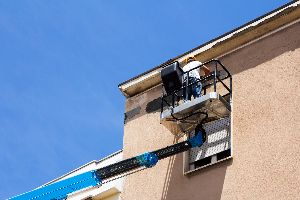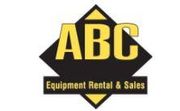4 Common uses for a Boom or Scissors Aerial Lift

Aerial lifts are a standard piece of construction equipment, featuring an extendable arm that simplifies the building process and increases the ease of other maintenance tasks. Their baskets come in different sizes and surround you with railings for security and peace of mind and can be maneuvered into areas that are difficult to reach, . If you’re planning a project and aren’t sure how these can help, come with me and let's take a closer look to see some of the most common uses for lifts.
What Projects Can Be Simplified With an Aerial Lift?
1. Which lift for which job?
Boom lifts come in two styles; rough terrain, (used outdoors) usually with a floating axle, and industrial booms with a rigid axle and electric power. RT lifts are used outside so they can flex with the terrain. Rigid frame boom lifts are used indoors or in parking lots which are level and paved with either concrete or asphalt. Changing lights, and working on wiring or plumbing are just a few of the common uses on the construction site.
Scissor lifts come in rough terrain and rigid frame designs. Rough terrain scissors are usually a gas or diesel engine and used outside and have very large platforms because of the large footprint of the machine, which creates their stability. The rigid units are usually electric and cannot drive when the grade goes past 3 degrees front to back and 1.5 degrees side to side, so they must be on fairly level concrete or asphalt. This is because the smaller frame makes them susceptible to tipping easier than rough terrain units.
2. Roof, Siding, Trim and Window Installation

While you could use ladders or scaffolding to reach these working heights, safety is paramount these days and an aerial lift will do the job with a much higher safety factor and higher productivity.
Once in place, a locking mechanism will hold its position and allow workers to get close enough to complete the work. Plus, with a weight limit of between 500 and 1,000 pounds, they can easily transport sheets of flashing, rolls of underlayment, and packs of shingles and tools needed to install the items.
3. Tree Removal
Tree removal is a common use of Aerial Lifts today (rough terrain Boom lifts mostly). The operator goes up with his harness and lanyard on along with safety equipment, ropes and chain saw and can cut and drop the pieces to the ground safely. It is important to make sure the base of the machine is not directly under the basket so falling wood does not damage the lift. Booming out away from the drop zone will help achieve this.
Wood is not transported in the baskets but rather fell in small pieces to the ground. Using the lift in this way is limiting the chance of the chain saw operator being hurt or much worse. It is important to never stand on the rails of the man basket.
3. Safety Inspections
Inspecting the upper parts of a new building usually requires a series of scaffolding and ropes. Aerial lifts alleviate the need to set up this intricate system and provide direct access to frame sections that might be out of reach. The inspector can simply stand in the bucket while a worker moves it around, getting a close-up view that lets them determine the quality of construction. A small gate along the side of the cage lets them step out onto certain areas where they need to test the structure's stability.
If you think an aerial lift could streamline an upcoming project, reach out to ABC Equipment Rental & Sales. This Equipment Rental Store and Kubota® dealer is located in Brunswick, OH, and maintains a vast inventory of construction and landscaping equipment. Each piece undergoes routine maintenance and is available at some of the most competitive rates in the industry. You can find a complete list of available products on their website. Call (330) 220-4545 to schedule a pickup.
About the Business
Have a question? Ask the experts!
Send your question

